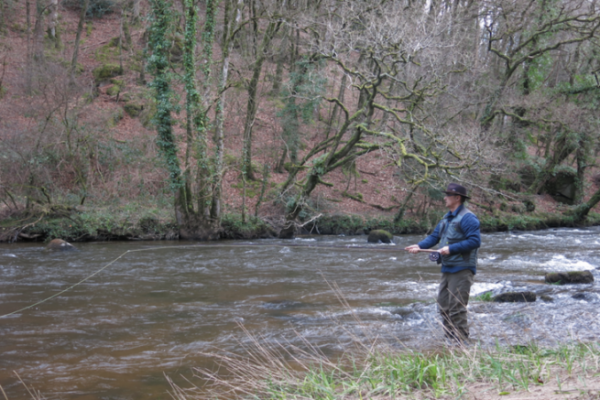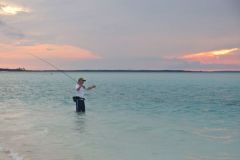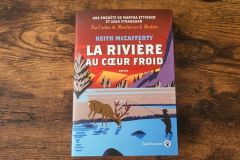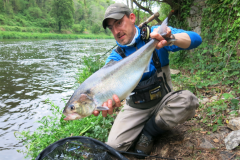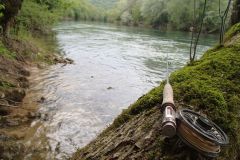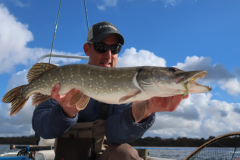Choose the right equipment for the local rivers
Each region or river requires specific equipment to search for salmon on the fly. It depends on the width of the river, to choose the rod, but also on its depth, to choose one or several adapted lines.
In Brittany, on some small rivers, equipment designed for fishing in reservoirs (9 to 10 feet of 8 gauge line) may be suitable, but in many cases, you will need to acquire a rod and reel set adapted to the rivers where you wish to begin this technique.
-
One-handed cane and switch
In small rivers less than 15 m wide, a one-handed rod of 10 feet for 7 or 8 line will do. It is possible to go down to a line of 6 for the castillon. This is the case on some rivers in Brittany and Normandy.
For rivers from 15 to 25 m wide, a Switch rod (two-handed rod less than 12 feet) will be necessary and will allow you to cast farther and to make better drifts and control your fly.
Beyond that, a longer Spey rod should be used
-
Two-handed cane or Spey
On large rivers over 25 m wide, especially on the Pyrenean Gaves and abroad, the use of two-handed rods of 13 to 15 feet is the norm.
When you need to cast regularly at more than 25 m to more than 35/40 m, this is the equipment you should buy.
13 feet of 8 or 8/9 silk - 14 feet of 9 silk - 15 feet of 10 silk or intermediate sizes.
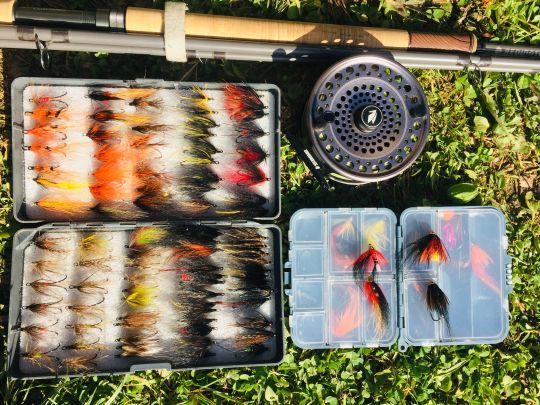
Traditional or Scandinavian silks ?
Today, there is a wide selection of fly lines available for salmon and migratory fish. It is the combination of rod and line that will allow you to cast. A good rod with a bad line will do you no good, and vice versa.
Finding the right line for your casting technique, river size and type of fishing is sometimes complicated because there is so much to choose from.
Do not hesitate to ask for advice from competent dealers or to search the internet.
To make a long story short, compact lines (5 to 8 m) like Skagits are to be put aside. They are mainly used to cast large diving tips and/or bulky and weighted flies mainly for steelhead and large sea trout (Argentina, Iceland, Sweden). In France, they have little or no use.
Prefer shooting head type lines from 12 to 15 m (medium and long belly) for big rivers.
Scandi silks for medium to large rivers (under 40 m wide).
Switch silks for smaller rivers or "big" rivers in Brittany and Normandy.
What you need to look at is the length of the spindle (type). Short for small rivers and longer for larger rivers. The longer it is, the more you need to master the casting techniques.
These lines are classified by rod power or in grains/gram which is the weight that allows you to load your rod. It is important to have the right weight of line for each rod. When you are a beginner, it is possible to overload your rod to make your casts easier. The more technique you acquire, the closer you get to the weight given for the power of your rod.
Most people use floating lines and add sinkers or polyleaders. This works well except when the rivers are either very powerful, and/or deep. In this case, diving lines (intermediate to very diving) or several densities called 3 D are to be had in its possession.
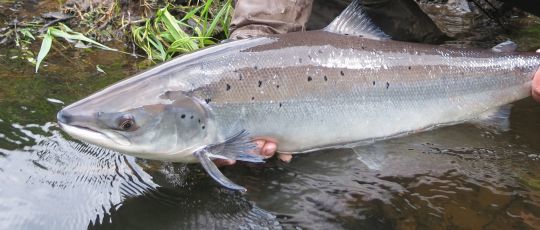
Learning the throwing technique
Salmon fishing is practiced by rolling casts, but mostly with Spey casts, also called Spey Casting technique.
These casts, which originated in Scotland on the River Spey, allow you to change direction and throw effortlessly to long distances with little clearance.
This casting technique consists of 4 basic casts that are important to master with both hands in order to be able to fish from both banks depending on the course.
It is possible with a lot of work to acquire the basics alone, but the help of a guide, casting instructor or a member of a migratory association or club is almost inescapable as these techniques require rigor and mastery.
On smaller rivers, rolling casts may be appropriate, but in this case, casts do not exceed 15 m. But spey casts are much more useful and practical for changing direction and covering the pools of a river well.
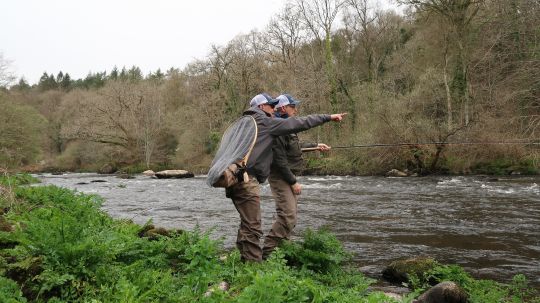
How do you approach fly fishing for salmon?
This is a downstream prospecting fishery. You have to scan the salmon spots called "pools" or "holes" with your flies to find a biting fish. We must pass at the right depth, with the right angle and speed but also find the colors and vibrations that will make our salmon bite.
It is possible to use flies on single, double or triple hooks and also mounted on tubes, called tube flies.
The salmon, whether spring (2 winters at sea) or summer (1 winter at sea), go upstream to spawn and do not feed. It bites only by aggressiveness.
When a salmon takes the fly, do not hook, but wait until the line is taut and the fish leaves. A rod lift will be enough to hook him.
Today, there are many tutorials on casting and also on fishing techniques. This allows you to get your foot in the door. Nevertheless, it is a very particular fishing that requires a lot of time, experience and knowledge to know how to cast, to find the places where the fish are held and how to present a fly correctly according to the conditions.
You have two options.
- The first is to practice throwing on your own and then after a little research on the internet and with the help of specialized books, to try your luck. If you have a friend or an acquaintance, the information you can get will be good to take.
- The other option is to use a professional fishing guide or with members of a fly club or association.
